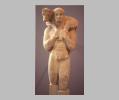
Acropolis Kriophoros: frontal view

Calf-bearer, frontal view
| Collection: | Athens, Acropolis Museum |
| Title: | Moschophoros, or Calf-bearer |
| Context: | Excavated at Athens, Acropolis |
| Findspot: | Excavated at Athens, Acropolis, in the area of the museum (in 1864). The base and foot were found in same area three years later. |
| Summary: | Male figure carrying calf over shoulders |
| Material: | Marble |
| Sculpture Type: | Free-standing statue |
| Category: | Single sculpture |
| Style: | High Archaic |
| Original or Copy: | Original |
| Date: | ca. 570 BC - ca. 560 BC |
| Dimensions: | Restored H. 1.65m, without base |
| Scale: | Life-size |
| Region: | Attica |
| Period: | High Archaic |
Subject Description: Mature male figure, his nudity tempered by a cloak, carries his offering of a male calf over his shoulders. The statue seems to represent the dedicator himself, who is named on the base as [Rh]onbos. His pose is essentially that of a kouros, his individuality emphasized by the beard, mantle and his calf. It is not a portrait in the literal sense of the word but probably should be seen as a symbolic representation of this man. There was a tradition of such dedications in the Greek East. At the same time that the individual gains prominence in Athens, albeit in idealized form, the sculptor also takes on a new respectability. On the basis of a peculiar treatment of the toes, the Moschophoros has been linked with a kore signed by Phaidimos, a sculptor associated with two other bases as well. He is the first Attic sculptor to sign his work, about the time vase painters adopt this practice as well. As Stewart notes, it is perhaps significant that this takes place shortly after Solon's reforms promote the role of artisan.
Form & Style: The man and animal are expressly bound as a group. The obvious compositional scheme of the crossed legs and arms as well as more subtle links such as the inclined heads create an extremely unified work. The forms are simple and often schematic: the face round, the eyes, brows and mouth created with simple arcs, the navel button-like, the mantle indicated by lines and points, the beard merely a raised surface presumably delineated in paint. However, the body structure is well developed, and there is a tremendous interest and accomplished virtuosity in rendering texture. The subtle modulation of musculature shows even through the cloth, not because it is thin but because it is soft. Similarly the genitals of the calf flatten against the shoulder of the man. His body shows a concomitant response to the calf with a tensing of the forearms as they balance the weight of the animal.
Condition: Fragmentary
Condition Description: Lacking legs below knees. Hands, front of left thigh and genitals have been chipped away. Chin broken off. Foot with plinth and inscribed base certainly belong. Inlaid eyes are missing. Excellent preservation of surface.
Material Description: Hymettian Marble
Inscription:
Sources Used: